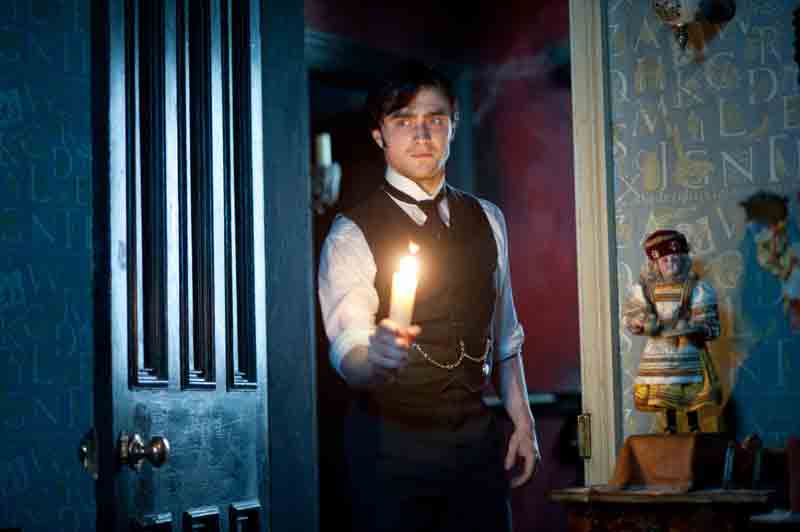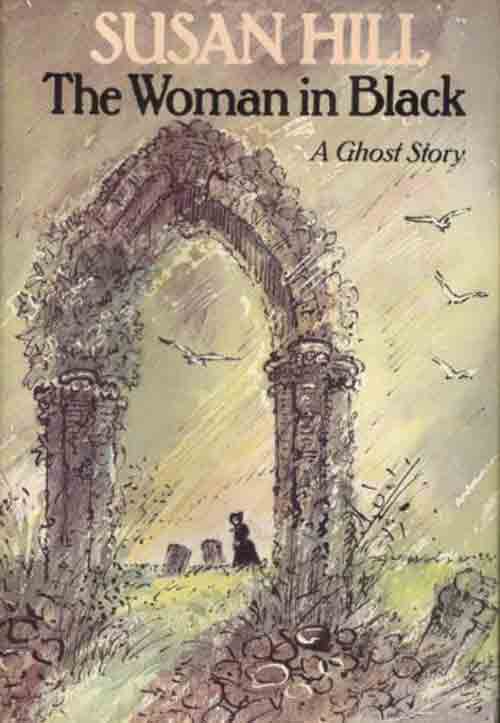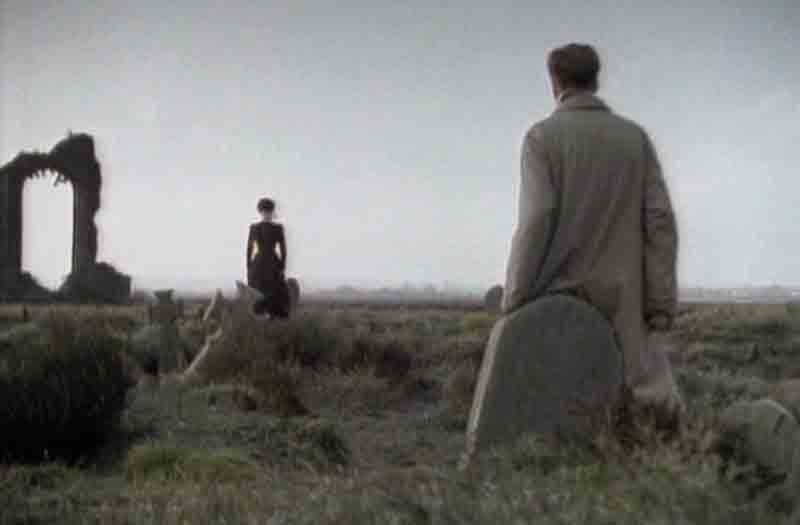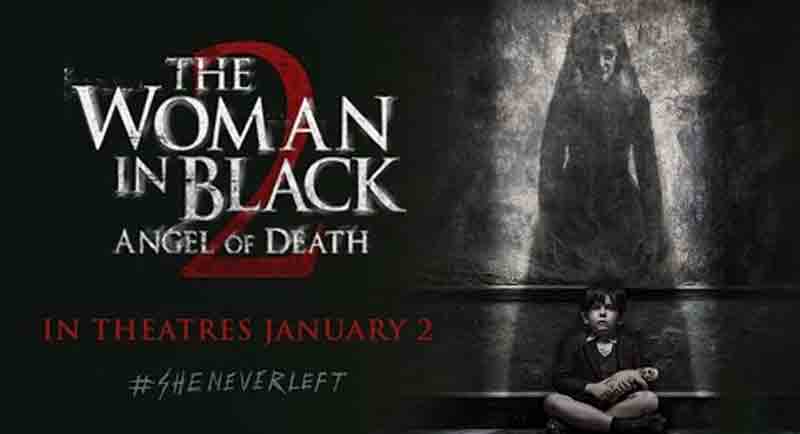BARRY McCANN traces how the saga of Susan Hill’s The Woman in Black has evolved from book to the theatre to the big screen

The Woman in Black: The Novel (1983)
Susan Hill’s novel was written as a pastiche of the Edwardian/Victorian ghost story with nods to other literary works of the period.
The protagonist, Arthur Kipps, references H.G. Wells’ character of the same name.
His employer Mr. Bentley, a Dickens of a genial soul, assigns Kipps to handle Mrs. Drablow’s estate to advance himself.
However, it is haunted by her ghostly sister, Jennet Humpfrye, who appears each time a child suddenly dies in the nearby town of Crythin Gifford.

The Woman in Black is initially an omen of doom and it is uncertain whether her manifestations influence the deaths or simply anticipate them. However, once Kipps is active in Eel Marsh House, she stalks and toys with him, the subsequent destruction of the building probably by her hand.
But that is not the end of it.
The vengeful spirit so cruelly deprived of her son in life follows Kipps back to London, and waits until he has a wife and child of his own before directly ensuring he loses them in a riding “accident.”
It is clear the woman spitefully resented him having what she once had and curses him to suffer likewise.
The Woman in Black: The Play (1987)
Adapted by Stephen Mallatratt, the stage version premiered in Scarborough, December 1987.
It arrived in London’s West End two years later and has been running at the Fortune Theatre ever since.
This telling is a play within a play, with an elderly Kipps engaging a young actor to coach him in delivering a public reading of his story.
They decide to perform the tale with the Actor playing the young Kipps, and Kipps himself playing the other parts.
Thus the play is a two handed piece… Except it is actually three, as somebody unknown starts appearing onstage.
Reaching the end of Kipps’s manuscript, the Actor congratulates the man both on the surprise of the mysterious actor playing the woman.
But Kipps has no idea who he is talking about, thus adding a unique twist on this version of the tale.
The Woman in Black: The TV Film (1989)
The first adaptation of Hill’s novel on film was entrusted to Nigel Kneale who, while closely following the plot, deepened and widened the narrative, making the characters more complex, edgy and believable.
In short he transformed Hill’s pastiche into more of an “authentic” Edwardian ghost story.
The whimsically named Arthur Kipps was rechristened Arthur Kidd (played by Adrian Rawlings), while the fruity sounding Jennet Humfrye became the more neutral Janet Goss (Pauline Moran).
Kidd’s boss, Mr. Bentley (David Ryall), hung onto his name but his character was redrawn as antagonistic and sneering towards his junior, who in this version is already married with young children.

Bentley is seemingly reluctant about sending Kidd to attend
the late Mrs. Drablow’s estate but professes to be unavailable himself.
In a later Kneale originated scene, it becomes apparent Bentley knew more than he was letting on and sent Kidd because he was afraid.
The presence of the Woman herself is also steadily enlarged. Initially a blurred figure in the distance, Kidd’s first direct confrontation with the figure reveals her as medusa like with a threatening, unblinking stare.
The second face to face encounter proves even more terrifying when the spectre descends down onto Kidd’s bed like a screeching raven.
Kneale also introduced a technological technique in revealing the ghost’s background by having Kidd discover wax cylinder recordings on which the late Mrs. Drablow recounts the whole sorry tale.
She in effect becomes a voice from the dead without physical form, while her tragic sister is a ghost without a voice.
Unlike the Kipps of the novel and stage play, Kidd does not live to tell his tale.
Rowing his family across a park lake, he sees the spectre stood on the surface of the water before a tree collapses down on top of them.
Question is, did it fall or was it pushed?
The Woman in Black: The Hammer Film (2012)
For the first cinematic version, screenwriter Jane Goldman evolved the story even further from the Hill original.
This young Kipps (Daniel Radcliffe) has already been married and widowed, his wife Stella (Sophie Stuckey) dying while giving birth to his now four year old son, Joseph (Misha Handley).
Having to cope with the loss and bringing up the child with the help of a nanny, Kipps is left badly affected.
Mr. Bentley (Roger Allam) is a cold figure no longer prepared to carry his struggling junior and entrusts him with Mrs. Drablow’s estate as a last chance to prove himself.
Cryfon Gifford is a place besieged with fear and hostile mistrust of outsiders, apart from Sam Daily whose own wife has been left unbalanced following the loss of their young son by drowning, attributed as the work of you know who.
10 fun facts you never knew about The Woman in Black (2012)
The Woman this time is no simple spectre of omen.
She exerts total hypnotic control over her young victims, mesmerising and commanding them to take their own life and seemingly collecting their spirits.
This influence does not extend to adults, but threatening their children gives her power enough over them.
In the end, she gets Kidd by luring his son onto a rail line and the pair of them killed as he tries to rescue the boy.
But, now in the afterlife, they are happily reunited with Stella.
Whether this was the Woman’s intention or pure happenstance we are left to guess at.
However, Eel Marsh House avoids being burnt down this time, which proved just as well.
The Woman in Black: The Sequel (2015)
With the success of the first film, Hammer decided on a sequel set during the outbreak of World War Two.
The original proposal was to have Eel Marsh House commandeered by the War Office as a mental home for service personnel which re invokes the ghost and, one by one, they fall victim to the Woman in Black.
Collaborating with Susan Hill, the finished screenplay was written by Jon Croker.
Given the Woman’s victims had previously been children, the idea was revised so that Eel Marsh becomes a (dilapidated) refuge to London evacuees, However the equating of manifestation with madness was adapted into having the Woman use a disturbed mute child as her focus, possibly seeing him as a kindred spirit given she starts despatching his bullies.
Woman in Black: Angel of Death is generally perceived as the poor follow up, but it does have much going for it. Whereas Jane Goldman’s screenplay meandered in places, Jon Croker’s leaner narrative remains more sharply focused.
Once events in Eel Marsh House start kicking off, the tension is relentless right up to the end.
The film also pays more homage to the 1989 adaptation than its immediate predecessor, not only in casting its star Adrian Rawlins (as Dr Rhodes) but in having the two protagonists unearth the story of the ghost via cylinder recordings made by Mrs. Drablow – now, where did that idea come from?
The Woman in Black: What Next?
If made, a further sequel would presumably bring the storyline into a contemporary.
Or maybe a more faithful adaptation of the novel realised in the M. R. James style.
In the meantime a re issue of the rarely seen 1989 masterpiece would not come amiss.









David Thewliss? David Ryall played Sweetman, Arthur Kidd’s boss in the 1989 version.
Thanks for picking this up Mark 🙂
You are right, Mark. Yes it is Ryall – don’t know how Thewliss managed to slip in! Can we amend this, Spooky Isles?
Of course!
No problem, although I would have liked to have seen what Thewliss would have done with the role! Great piece by the way Barry . As sequels go, I really enjoyed ‘Angel of Death’. I wonder if they will decide to do another.
Hi Mark. I think a third film set in contemporary times would be intriguing. Unfortunately, Hammer seem to be taking a back seat on film production at the moment, so remains to be seen.